RETURN
TO . . .
Emsworth
Wildlife - Homepage
THE
HERMITAGE MILLPONDS
The two millponds to
the east of the town are usually referrred to as the
Hermitage Millponds. They are privately owned. Peter
Pond is owned by the Kinloch family and is managed by
David Gattrell. Slipper Millpond is owned by the
Slipper Millpond Preservation Society who also manage
its banks and sluices. The two eastern millponds have
a more natural habitat than the town millpond, with
reedbeds and bankside vegetation. They are connected
through a culvert beneath the A259 road through
Emsworth. The millponds are important habitats for a
number of waterbirds. Both ponds were designated Sites
of Nature Conservation Importance (SNCI) in 1997. They
are also immediately adjacent to Chichester Harbour, a
Site of Special Scientific Interest (SSSI). Slipper
Millpond (but not Peter Pond by some strange
administrative quirk) is also inside the Chichester
Harbour Area of Outstanding Natural Beauty (AONB).
Link to Peter Pond .
. . Peter
Pond
SLIPPER
MILLPOND
A view
of Slipper Millpond looking north from the sluice gate
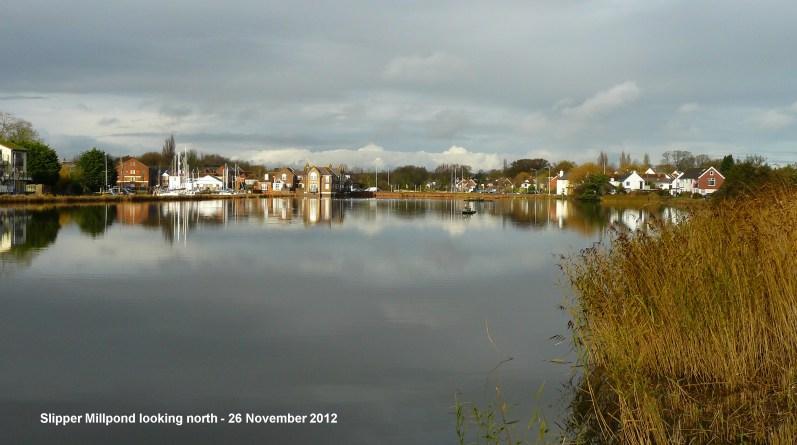
A view
of the footpath to the west of Slipper Millpond
looking north, with Dolphin Lake on the left

Both Hermitage ponds
are tidal though the sluice gates at the southern end
of Slipper Millpond hold the water when the tide
falls. When the tide is very high the ponds and
surrounding areas can be flooded. The path on the west
side of Slipper Millpond is often flooded at high
tide, but it is rarely as bad as in the following
photo.
Slipper
Millpond flooded by exceptional tides in November
2005
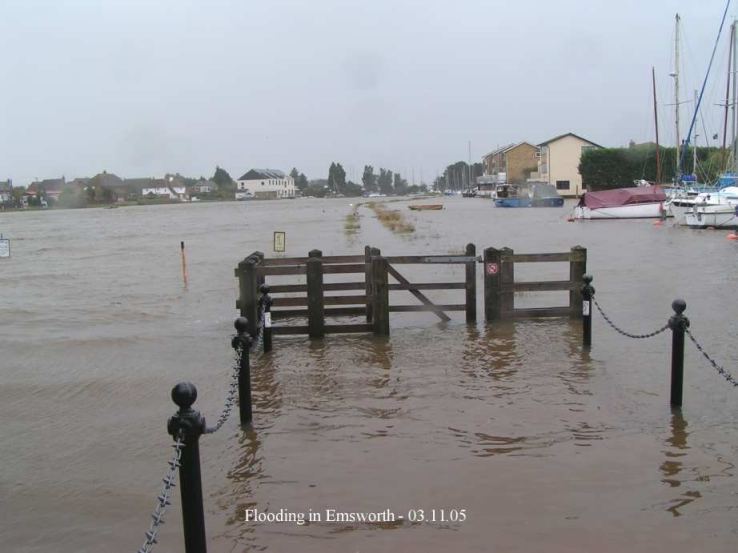
BIRDS
OF SLIPPER MILLPOND
The pond is attractive
to birds throughout the year. Mute Swan, Mallard,
Coot, Moorhen and Black-headed Gulls are always
present. They are joined by Cormorant, Little Grebe
and Little Egret in winter along with masses of other
gulls, including Common Gull, Herring Gull,
Mediterranean Gull, Lesser Black-backed Gull and Great
Black-backed Gull. Also, occasionally present in
winter are Canada Geese, Great Crested Grebe, Tufted
Duck and Red-breasted Merganser, while Kingfisher is
often seen flying low over the pond.
In summer Reed
Warblers sing from the reedbeds on the east side and
Common and Sandwich Terns fish in pond. The main
breeding birds are Coot which nest on the three
floating rafts and sometimes produce more than one
brood. Mallard probably nest somewhere around the
edges of the pond and families of ducklings are a
common sight in summer. Visiting pairs of Mute Swans
ocasionally build a nest on the side of the pond, but
they are rarely successful, due mainly to the nests
being washed away by the high tides. The resident pair
of Mute Swans regularly nest on Peter Pond and patrol
Slipper Millpond to see off any intruders. Moorhen
nest in Dolphin Lake.
Mute
Swan nest flooded by the high tide and the eggs
lost

GREAT
BLACK-BACKED GULLS
A pair of
Great Black-backed Gulls nested, probably for
the first time ever in Emsworth, on the centre raft on
Slipper Millpond in 2012. It was a fascinating
experience to watch the progress of these magnificent
birds, through nest building, laying, sitting,
hatching, tending to the young and finally fledging.
It did not all go smoothly and they had some hard
times as the weather was awful. However, they came
through it all and good luck to them.
The full story of the nesting with photos is on a
special page at . . . Great
Black-backed Gull nesting
COOT
Coot are the
only regular nesting birds on Slipper Millpond. Three
pairs usually build their nests in the nest boxes
provided on on each of the rafts. They often have more
than one brood, with the offpring of earlier broods
helping with the the later ones. The first photo shows
an exceptionally large brood of six chicks on the
nesting raft.
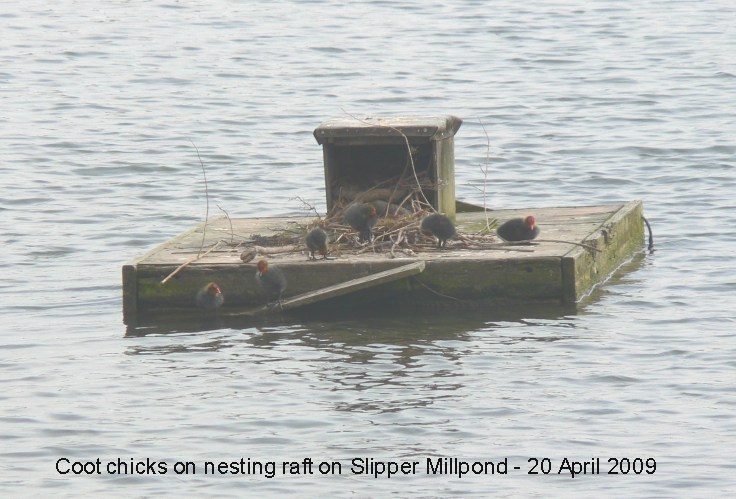
Parent Coot are very
attentive to their young and keep them well fed.
Though they can also be rather harsh and give them a
good spanking at times.
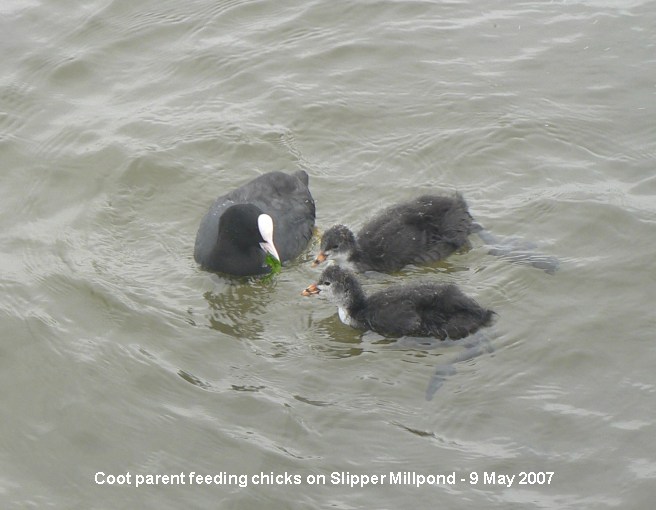
Here
are Coot chicks hiding away from enemies in the
reeds

Here
is a pair of Coot engaged in a feeding ritual in which
one passes food to the other
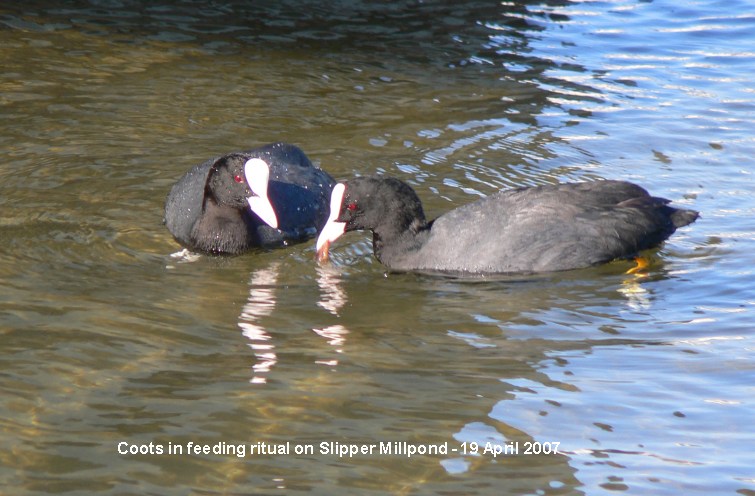
Sometimes
Coot get into a dispute, usually over
ralationships

OTHER
BIRDS
Cormorants
are common on the pond in winter. They can often be
seen fishing.
This one with a grey head caught an Eel and finally
swallowed it after several minutes of thrashing
around.
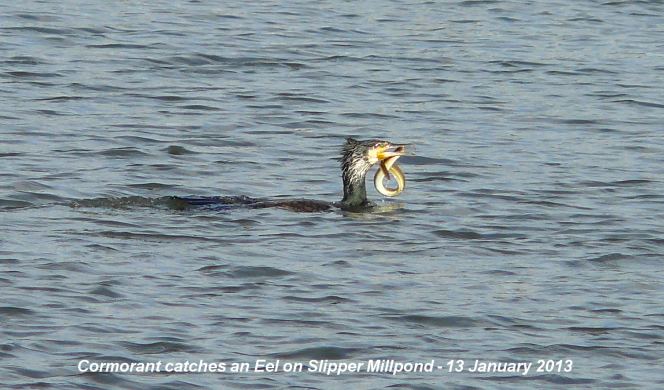
Common
Sandpiper is an infrequent visitor to the pond usually
in spring

Terns
regularly dive for fish in the pond in summer, but
this juvenile was a one-off

Mute
Swans
The resident male Mute
Swan of the pair that nest on Peter Pond vigorously
defends Slipper Millpond from intruders. These photos
were taken in March 2013 when the male of the resident
pair was relentlessly pursuing what I assume was the
male of an intruding Mute Swan pair. The resident male
shwon here chased the intruder with the standard
threatening posture of wings raised and head down.

This
chase never got really violent, though there were
several skirmishes.

A second pair of Mute
Swans have nested on Slipper Millpond in previous
years, though never successfully. We shall see what
happens this year.
Lesser
Black-backed Gull
Lesser Black-backed
Gull is an occasional winter visitor to the millpond.
This one below is an adult in breeding plumage. Note
its bright yellow legs and feet, which clearly
distinguishes it from the larger Great Black-backed
Gull which has pink legs and feet. The very dark back
of this bird suggests it is of the Danish race
intermedius which breeds in SW
Scandinavia. The birds of the British race graellsii
has slate grey upper parts. Both races winter in
Western Europe and south to West Africa, so can be
seen in this area.
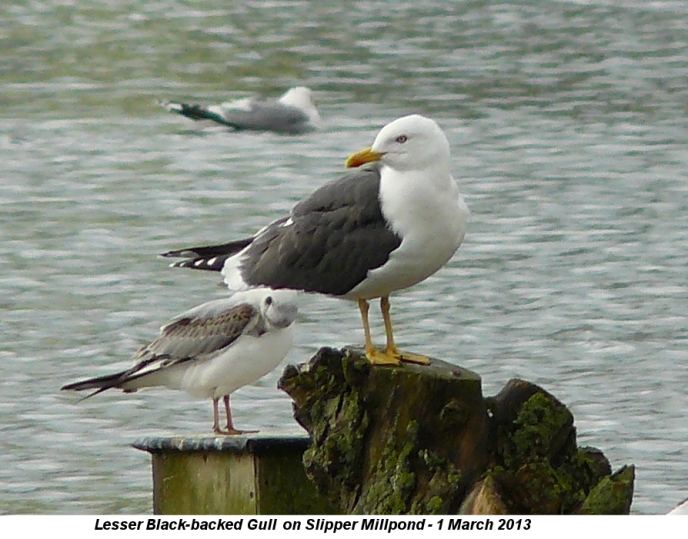
Little
Egret
Little Egrets are
fairly common on the rafts on the millpond. they
particularly like fishing in Dolphin Lake which is
adjacent to Slipper Millpond. This one in march 2013
had fine breeding plumes which were much sought after
for the costume trade in the 19th Century and which
almost led to the extinction of this fine bird.
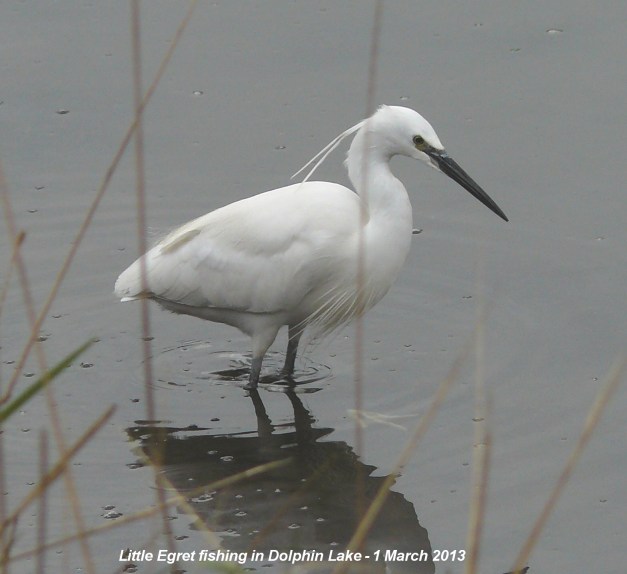
LIST
OF BIRDS RECORDED ON SLIPPER MILLPOND
|
Little
Grebe
|
Regular
winter visitors: up to 4
|
|
Great Crested
Grebe
|
Occasional
winter visitor
|
|
Cormorant
|
Regular
winter visitors: up to 13
|
|
Great
Northern Diver
|
Rare -
Brendan Gibb-Gray 02.04.06
|
|
Little
Egret
|
Regular: up
to 2
|
|
Grey
Heron
|
Occasional
throughout the year
|
|
Mute
Swan
|
Regular.
Pairs occasionally nest
|
|
Canada
Goose
|
Occasional
visitors.
|
|
Emperor Goose
|
Rare
|
|
Bar-headed
Goose
|
Rare
|
|
Barnacle
Goose
|
Rare. Brendan
Gibb-Gray 01.08.08
|
|
Greylag Goose
|
Rare. Brendan
Gibb-Gray 27.04.06
|
|
Shelduck
|
Rare
|
|
Gadwall
|
Rare
|
|
Shoveler
|
Rare
|
|
Mallard
|
Regular - up
to 50. Occasionally nesting.
|
|
Pochard
|
Rare
|
|
Tufted
Duck
|
Occasional
winter visitors
|
|
Goldeneye
|
Rare winter
visitor
|
|
Red-breasted
Merganser
|
Occasional
winter visitors
|
|
Goosander
|
Rare winter
visitor
|
|
Moorhen
|
Regular all
year. Nest Dolphin Lake
|
|
Coot
|
Regular: Up
to 90 in winter. 3 pairs nest
|
|
Lapwing
|
Rare - at low
water
|
|
Black-headed
Gull
|
All year. Up
to 2,000 winter
|
|
Common
Gull
|
Regular in
winter - up to 50.
|
|
Herring
Gull
|
Regular in
winter - up to 50
|
|
Mediterranean
Gull
|
Occasional in
winter
|
|
Lesser
Black-backed Gull
|
Regular in
winter
|
|
Great
Black-backed Gull
|
Regular in
winter. Nested April 2012
|
|
Kittiwake
|
Rare
|
|
Common Tern
|
Regular
summer visitor
|
|
Sandwich Tern
|
Occasional
summer visitor
|
|
Greenshank
|
Rare - at low
water
|
|
Common
Sandpiper
|
Occasional
|
|
Kingfisher
|
Regular over
pond in winter
|
|
Swallow
|
Regular in
summer
|
|
Grey
Wagtail
|
Occasional
|
|
Pied Wagtail
|
Occasional
around the pond
|
|
Sedge
Warbler
|
Rare
|
|
Reed
Warbler
|
Regular
summer visitor
|
TUBE
WORM CASTS
The coral-like
calcareous aggregates produced by Tube Worms are very
prominent when the sluice gates are opened to let the
water out to do repair work.
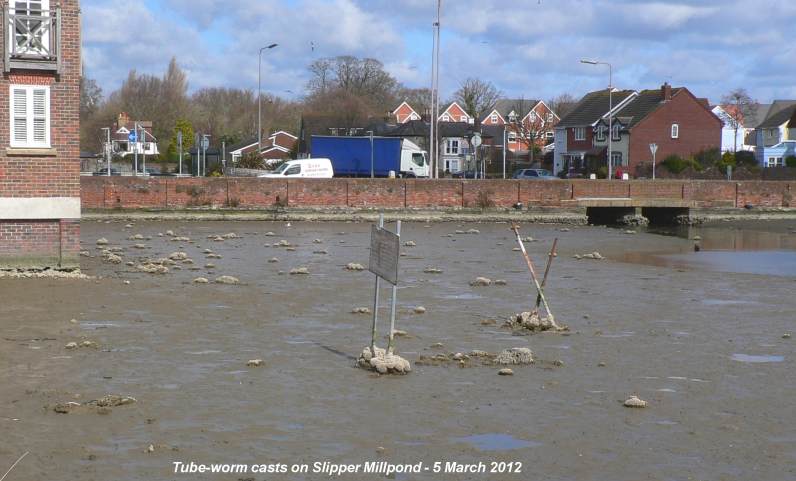
These casts are
produced by the Bristle Worm (Ficopomatus
enigmaticus), which plays a very significant role
in the pond's eco-system. The aggregated tubes of the
Bristle Worm provide not only an additional habitat
for other organisms but their presence is beneficial
for the ponds as a whole.
Tube-worm
casts close up.

FISH
Large
shoals of Grey Mullett can also be seen in the pond,
basking in the shallow water

Plant
Records for SU70M - Slipper Millpond - July
2006
From Rod Stern -
Sussex Botanical Recording Society
|
Annual Meadow Grass
|
Poa
annua
|
|
Annual Pearlwort
|
Sagina apetala ssp.
erecta
|
|
Annual Sea Blite
|
Suaeda
maritima
|
|
Barren Brome
|
Anisantha
sterilis
|
|
Black Horehound
|
Ballota
nigra
|
|
Black Medick
|
Medicago
lupulina
|
|
Black Mustard
|
Brassica
nigra
|
|
Black Spleenwort
|
Asplenium
adiantum-nigrum
|
|
Bramble
|
Rubus fruticosus
agg.
|
|
Bristly Oxtongue
|
Picris
echioides
|
|
Broad-leaved Dock
|
Rumex
obtusifolius
|
|
Buckshorn Plantain
|
Plantago
coronopus
|
|
Butterfly Bush
|
Buddleja
davidii
|
|
Cleavers
|
Galium
aparine
|
|
Clustered Dock
|
Rumex
conglomeratus
|
|
Cocksfoot
|
Dactylis
glomerata
|
|
Columbine
|
Aquilegia
vulgaris
|
|
Common Birdsfoot
Trefoil
|
Lotus
corniculatus
|
|
Common Brome
|
Bromus
hordaeceus
|
|
Common Chickweed
|
Stellaria
media
|
|
Common Comfrey
|
Symphytum
officinale
|
|
Common Fleabane
|
Pulicaria
dysenterica
|
|
Common Mallow
|
Malva
sylvestris
|
|
Common Nettle
|
Urtica
dioica
|
|
Common Ragwort
|
Senecio
jacobaea
|
|
Common Reed
|
Phragmites
australis
|
|
Creeping Buttercup
|
Ranunculus
repens
|
|
Creeping Cinquefoil
|
Potentilla
reptans
|
|
Creeping Thistle
|
Cirsium
arvense
|
|
Curled Dock
|
Rumex
crispus
|
|
Cut-leaved
Cranesbill
|
Geranium
dissectum
|
|
Dandelion
|
Taraxacum
agg.
|
|
Dove's-foot
Cranesbill
|
Geranium
molle
|
|
Druce's Cranesbill
|
Geranium x
oxonianum
|
|
Elder
|
Sambucus
nigra
|
|
Equal-leaved
Knotgrass
|
Polygonum
arenastrum
|
|
False Oat Grass
|
Arrhenatherum
elatius
|
|
Fennel
|
Foeniculum
vulgare
|
|
Feverfew
|
Tanacetum
parthenium
|
|
Field Bindweed
|
Convolvulus
arvensis
|
|
Gipsywort
|
Lycopus
europaeus
|
|
Goat Willow
|
Salix
caprea
|
|
Golden samphire
|
Inula
crithmoides
|
|
Gorse
|
Ulex
europaeus
|
|
Grass-leaved Orache
|
Atriplex
littoralis
|
|
Greater Celandine
|
Chelidonium
majus
|
|
Greater Plantain
|
Plantago
major
|
|
Greater Sea Spurrey
|
Spergularia
media
|
|
Grey Sedge
|
Carex
divulsa
|
|
Ground Elder
|
Aegopodium
podagaria
|
|
Groundsel
|
Senecio
vulgaris
|
|
Hard Grass
|
Parapholis
strigosa
|
|
Hartstongue Fern
|
Phyllitis
scolopendrium
|
|
Hawthorn
|
Crataegus
monogyna
|
|
Hedge Bindweed
|
Calystegia
sepium
|
|
Hedge Mustard
|
Sisymbrium
officinale
|
|
Hedge Woundwort
|
Stachys
sylvatica
|
|
Hemlock
|
Conium
maculatum
|
|
Hemlock Water
Dropwort
|
Oenanthe
crocata
|
|
Hemp Agrimony
|
Eupatorium
cannabinum
|
|
Herb Robert
|
Geranium
robertianum
|
|
Hoary Willowherb
|
Epilobium
parviflorum
|
|
Hogweed
|
Heracleum
sphondylium
|
|
Horseradish
|
Armoracia
rusticana
|
|
Ivy
|
Hedera
helix
|
|
Japanese Rose
|
Rosa
rugosa
|
|
Keeled-fruited
Cornsalad
|
Valerianella
carinata
|
|
Knotgrass
|
Polygonum
aviculare
|
|
Large Bindweed
|
Calystegia
silvatica
|
|
Lesser Swinecress
|
Coronopus
didymus
|
|
Lilac
|
Syringa
vulgaris
|
|
Mexican Fleabane
|
Erigeron
karvinskianus
|
|
Mugwort
|
Artemisia
vulgaris
|
|
Nipplewort
|
Lapsana
communis
|
|
Opium Poppy
|
Papaver
somniferum
|
|
Pellitory-of-the-wall
|
Parietaria
judaica
|
|
Perennial Rye
Grass
|
Lolium
perenne
|
|
Perennial
Sow-thistle
|
Sonchus
arvensis
|
|
Perforate St.
John's-wort
|
Hypericum
perforatum
|
|
Petty Spurge
|
Euphorbia
peplus
|
|
Pineappleweed
|
Matricaria
discoidea
|
|
Prickly Lettuce
|
Lactuca
serriola
|
|
Procumbent Pearlwort
|
Sagina
procumbens
|
|
Purple Toadflax
|
Linaria
purpurea
|
|
Red Bartsia
|
Odontites
verna
|
|
Red Clover
|
Trifolium
pratense
|
|
Red Deadnettle
|
Lamium
purpureum
|
|
Red Fescue
|
Festuca
rubra
|
|
Red Valerian
|
Centranthus
ruber
|
|
Redshank
|
Persicaria
maculosa
|
|
Ribwort Plantain
|
Plantago
lanceolata
|
|
Rosebay Willowherb
|
Chamerion
angustifolium
|
|
Scarlet Pimpernel
|
Anagallis
arvensis
|
|
Scentless Mayweed
|
Tripleurospermum
ssp.inodorum
|
|
Sea Beet
|
Beta vulgaris subsp.
maritima
|
|
Sea Carrot
|
Daucus carota ssp.
gummifer
|
|
Sea Club-rush
|
Bolboschoenus
maritimus
|
|
Sea Couch
|
Elytrigia
atherica
|
|
Sea Plantain
|
Plantago
maritima
|
|
Sea
Purslane
|
Atriplex
portulacoides
|
|
Sea-buckthorn
|
Hippophae
rhamnoides
|
|
Shepherd's-purse
|
Capsella
bursa-pastoris
|
|
Silverweed
|
Potentilla
anserina
|
|
Smooth Hawk's-beard
|
Crepis
capillaris
|
|
Smooth Sow-thistle
|
Sonchus
oleraceus
|
|
Spear Thistle
|
Cirsium
vulgare
|
|
Spear-leaved Orache
|
Atriplex
prostrata
|
|
Square-stalked
Willowherb
|
Epilobium
tetragonum
|
|
Stone Parsley
|
Sison
amomum
|
|
Swinecress
|
Coronopus
squamatus
|
|
Sycamore
|
Acer
pseudoplatanus
|
|
Teasel
|
Dipsacus
fullonum
|
|
Timothy
|
Phleum
pratense
|
|
Tree-mallow
|
Lavatera
arborea
|
|
Wall Barley
|
Hordeum
murinum
|
|
Wall Cotoneaster
|
Cotoneaster
horizontalis
|
|
Wall Rue
|
Asplenium
ruta-muraria
|
|
Wall Speedwell
|
Veronica
arvensis
|
|
Water
Bent
|
Polypogon
viridis
|
|
White Bryony
|
Bryonia
dioica
|
|
White Clover
|
Trifolium
repens
|
|
White Stonecrop
|
Sedum
album
|
|
Wild Onion
|
Allium
vinale
|
|
Wilson's
Honeysuckle
|
Lonicera
nitida
|
|
Wood Avens
|
Geum
urbanum
|
|
Wood Dock
|
Rumex
sanguineus
|
|
Yarrow
|
Achillea
millefolium
|
|
Yorkshire-fog
|
Holcus
lanatus
|
BRIEF
HISTORY OF SLIPPER MILL POND
by Tony
Wilkinson
Slipper Mill and its
tidal pond (ie Slipper Millpond) were built in 1760 by
Thomas Handy, a miller and merchant. Soil removed from
the pond was used to enlarge Hendy's Quay along the
west bank of the River Ems. By 1805 the pond had been
extended north of Hermitage Bridge forming today's
Peter Pond. By the middle of the 19th Century Slipper
Mill was part of a complex of four working mills in
Emsworth. The others were:
Quay Mill at the
bottom of South Street was also tide driven and is now
home to The Emsworth Slipper Sailing Club.
The Old Flour Mill at
the bottom of Queen Street which was powered by the
River Ems. It burned down in 1894 but was restored and
is now a preserved building.
Lumley Mill was also
powered by the River Ems and was also burned down in
1915, but was never rebuilt. The mill house is now
called Lumley Mill.
New Slipper Mill was
built by "Boney" Hatch in 1867 to be driven by a tidal
pond, known as "Big Bunny", which is now the Emsworth
Marina. The mill race, located by the floodgates in
the gap of the marina's north wall, never worked
effectively so a chimney for a steam engine was added
but the mill burned down in 1886 before it had become
operational. It was not re-built. The tidal pond of
the ill-fated New Slipper Mill was used for seasoning
timber for Foster's Yard until the pond was dredged
and the chimney removed during construction of the
marina in the 1960s.
History
of Slipper Mill and Slipper Millpond
By the late 19th
Century the area north of what today remains of
Hendy's Quay, now occupied by the Kings Quay housing
estate, was the site of a sawmill, boatyard and
slipway; this is where J.Dunnock Foster built his
famous Emsworth Oyster fishing fleet.
In the early 20th
century Slipper Mill was owned by James Thomas of
Newport, Isle of Wight. It produced wheat flour as
well as cattle cake, barley meal, maize flour and
fertiliser for local farmers. The tide gates are still
working after nearly a quarter of a millennium. The
miller's house, which was alongside the mill above the
race and water wheel, was demolished after being
damaged by a storm and very high tide in 1912. At
about the same time a brick store replaced the wooden
granary. (see picture on the pond information board).
After the First World
War (1914-18) Leigh Thomas took over from his father
both Slipper Mill and the Old Flour Mill in Queen
Street. Slipper Mill continued to be tide-driven until
the outbreak of World War Two when electrical power
from the National Grid was introduced. While wheat
flour production had long since ceased at both mills,
production and storage of animal feeds continued until
the mid-1960s when the Slipper Mill was demolished and
by 1969 the brick store had been converted into
houses. The Old Flour Mill in Queen Street closed in
1970 and has been converted into offices and
workshops.
In 1980 a group of 33
public-spirited local residents dubbed together to buy
Slipper Millpond to prevent its failing into the hands
of developers. It is now leased to the Slipper Mill
Pond Preservation Association.
FULLER
HISTORY OF SLIPPER MILLPOND
Tony Wilkinson July
2004
The Slipper Mill and
its tidal mill pond were built in the 1760s using
spoil removed from the pond to enlarge Hendy's Quay
along the west bank of the River Ems. By 1805 Slipper
Mill Pond had been extended north of the crossing
marked by Hermitage Bridge on the A259. This extension
is now known as Peter Pond.
By the middle of the
19th Century the tide-driven Slipper Mill was part of
a complex of four working mills in Emsworth. Quay Mill
at the bottom of South Street in Emsworth was also
tide-driven and is now home to the Emsworth Slipper
Sailing Club. The Old Flour Mill in Queen Street just
north of the Slipper Mill Pond and Lumley Mill on
Lumley stream stretch of the River Ems north of Peter
Pond both derived their power from the Ems. The former
was burned down in 1894 but was restored and finally
closed in 1972. The latter suffered the same fate in
1915 but was never rebuilt. In 1867 a fifth mill, New
Slipper Mill, was built to be driven by a tidal pond
which is now the Emsworth Yacht Harbour. The millrace,
located by the gap in the marina's north wall, never
worked effectively so a steam engine was planned but
this refurbished mill was also destroyed by fire in
1886 before it became operational.
By the late 19th
Century the area north of Hendy's Quay, now occupied
by the Kings Quay housing estate, was the site of a
sawmill, boatyard and slipway, where J.D. Foster built
the famous Emsworth Oyster fishing fleet. The Echo,
pride of the Emsworth Oyster smacks, was moored off
Hendy's Quay until the 1950s. The tidal pond of the
ill-fated New Slipper Mill was used for seasoning
timber for Foster's Yard until the pond was dredged
and the chimney removed during the construction of the
marina in the 1960s.
The area surrounding
the two ponds contains several buildings associated
with this heritage including the former Slipper Mill
store, the former mill in Queen Street and Lumley Mill
House on the River Ems. In particular the Slipper Mill
Pond is not only immediately adjacent to the Emsworth
Conservation Area but also lies within the Chichester
Harbour AONB (Area of Outstanding Natural Beauty). See
Map - Appendix One. The 1960s/1970s Kings Quay housing
estate on the eastern edge of the Emsworth
Conservation Area overlooking the pond is a large and
inappropriate intrusion into this traditional setting.
BIODIVERSITY
OF THE PONDS
Extracted from a
report by Tony Wilkinson July 2004
Peter Pond and the
Slipper Mill Pond are man-made brackish water coastal
lagoons of greatly varying salinity, fed with fresh
water from the River Ems and sea water which
automatically opens the tide gates when seaward
pressure exceeds that on the pond side. Such coastal
saline lagoons are rare and specialised habitats,
important at a UK level and listed as a priority
habitat on Annex 1 of the European Union Habitats
Directive. Both ponds were designated Sites of Nature
Conservation Importance (SNCI) in 1997. Such
recognition indicates the vital contribution made to
the biodiversity of this "significant local gap" by
the two ponds along with Brook Meadow which is also a
SINC (Site of Importance for Nature Conservation) in
Hampshire. The Chichester Harbour Conservancy
Biodiversity Action Plan identifies the need to
"target… plans to designate Emsworth Slipper Mill
Pond/Peter Pond as SSSI….and thence in the Solent
lagoons pSAC if possible." Biodiversity Action Plans
(BAP) play a crucial role along with the planning
process in protecting and promoting biodiversity.
Stretches along the
verges of both ponds are characterised by patches of
two types of reeds. These are the Common Reed
(Phragmites australis), which is mainly a fresh water
plant but tolerant of sea water and Sea Club-rush
(Scirpus maritimus), which is essentially a saline
friendly plant but also tolerates some fresh water
(See Appendix One - Map). Sea couch grass grows along
the outer edges of the footpath and helps reduce
erosion of the bank by rain and sea water.
Plants which are
physically prominent on the eastern bank of Slipper
Mill Pond include a Weeping Willow, two Buddleias and
a Buddleia globosa, several Tree Mallows, a Holly bush
and a Strawberry Tree (of the Arbutus family and
unusual for this location). The eastern bank of
Slipper Mill Pond, which was recovered from the
original beach, also supports a considerable variety
of other plants. In May 2004 Brian Fellows and Ralph
Hollins identified Pellitory-of-the-wall in flower and
growing in several places on the south-facing wall of
Hermitage Bridge.
Water moss (Fontinalis
antipyretica) and duckweed (Lemna sp.), both of which
are freshwater plants, were identified by Dr. Thorp in
his study of the two ponds' sediment inhabiting fauna
from core samples taken at Sites 1 and 2 on Peter Pond
in March 1998. A more recent study produced in January
2002 and conducted during a period of low salinity by
The Biogeography and Ecology Research Group of
Brighton University for English Nature noted the
"frequent" abundance of the following potentially
invasive species of algae (Spirogyra, Enteromorpha,
Derbesa, Chaetomorpha and Cladophora).
Flora from the sea may
also affect the ecological balance of the ponds. As
Dr. Thorp has noted, "at the end of July 1997, the
floor of Slipper Mill Pond became very thickly
carpeted with a very luxuriant growth of Ulva lactuca
(Sea Lettuce), possibly facilitated by prolonged high
salinities through most of the summer. A heavy growth
of Ulva persisted in the pond until October.
Coincident with the appearance of the Ulva, the
phytoplankton level within the pond fell dramatically
and did not recover, possibly due to nutrient
depletion of the pond water by the Ulva. Thus it is
possible that, with the phytoplankton being at the
bottom of the food chain, there was reduced 'food
source' available for many invertebrates to build up
necessary 'reserves' with which to overwinter."
Apart from limited
areas of muddy shingle, the floor of both ponds is
comprised mainly of both shallow and deep soft mud
that offers little stability for attaching organisms.
In normal circumstances the characteristic plant
growth within the ponds consists of prodigious numbers
of minute single-celled plants (diatoms) that turn the
water brown in Spring and Summer. The muddy bottom
sediments of both ponds have provided a "dynamic if
unstable" environment for invertebrates. Some 30
species have been identified in ongoing monitoring by
Dr. Thorp since 1983 and in a number of other studies
(See details in Appendix Three).
Some of these
invertebrates come from the sea and some from the
river but the most interesting are specialists
confined to brackish water. Of the latter group three
are of particular note. The Starlet Sea Anenome
(Nematostella vectensis) and the Tentacled Lagoon Worm
(Alkmaria romijni) are very rare species protected
under Schedule 5 of the Wildlife and Countryside Act
1981 and listed as endangered species in the IUCN Red
Data Book. The former is also the subject of a
national pSAP. As Dr. Thorp and others have observed
that a third species, the Bristle Worm (Ficopomatus
enigmaticus), seems to play a very significant role in
the economy of the ponds' eco-system.
The aggregated tubes
of the Bristle Worm provide not only an additional
habitat for other organisms but their presence is
beneficial for the ponds as a whole. Dr. Thorp has
noted that when it is prolific, other species become
more abundant. Conversely when less abundant so are
other organisms. The Bristle Worm plays an important
role in the food chain for both fish and birds and the
presence or otherwise of cormorants can be a visible
indication of fish stocks. The cormorant is therefore
the Slipper Mill Pond logo.
Dr. Thorp has pointed
out the damage which unnecessary, ill-timed or
prolonged drainage of the ponds can cause to the
invertebrate species, especially at times of
inappropriate low (Winter) and high (Summer) air
temperatures and over the Spring breeding season. He
states:
"With the advent of
Spring there is, however, a much greater concern for
the 'health' of the Mill Pond. It is a well-documented
fact that by far the majority of temperate-water
invertebrates are spring breeders. To breed
successfully the organisms will need to have
sufficient food (energy) reserves to fuel the very
energy consuming-process of producing eggs and sperm.
Of even greater importance, however, is the
requirement for the 'environment' to attain species
specific minimum temperature levels…it has been
demonstrated in the literature that many invertebrates
not only require specific minimum temperatures to be
reached and maintained, but also will not spawn
eggs/larvae into the overlying waters until there is
adequate, suitable food for their offspring in the
form of "plants"; the single-celled algae which form
the phytoplankton. This has a "knock-on" effect. No
phytoplankton - no spawning of many herbivorous
species. No herbivorous species in the zooplankton -
no spawning of the carnivorous species and so on to
food for resident fish populations, etc."
Fish species include
Salmon, Brown Trout (and occasional Rainbow), Sea
bass, Sea bream, Roach, Flatfish and Sticklebacks. The
Slipper Mill Pond in particular also provides a
nursery area for fish such as Flounder, Mullet, Sand
Smelt, Goby and Eels. There are also some shrimps and
prawns. Drainage of the ponds, or fishing in the ponds
or river during the Spring breeding season can also
adversely affect fish stocks. Fixed net fishing in the
pond is also occasionally a problem and contravenes
Chichester Harbour byelaws as it does in Dolphin Creek
and the Slipper Basin area (See paragraph 49 below).
The reed-lined edges
of both ponds, in particular Peter Pond, attract
Dragon Flies and Damsel Flies. Of the former the
Common Darter (Sympetrum striolatum) is quite often
present on both ponds. Of the latter, most commonly
seen is the Banded Demoiselle (Pyrrhosoma nymphula).
Both ponds support a
wide range of resident, breeding, wintering and
passage migrant birds. Breeding birds include the Mute
Swan, Mallard, Coot, Moorhen, Reed and Sedge Warblers
(see Appendix Four) prepared by Brian Fellows . Other
occasional visitors to the ponds include the Reed
Bunting, Common Snipe, Sparrowhawk, Smew and Kestrel.
While Emsworth's
western Mill Pond by Bath Road attracts large numbers
and varieties of birds it provides conditions less
favourable for breeding birds (although a pair of Mute
Swans did succeed in raising cygnets in 2003) or the
range of invertebrates found in Emsworth's other two
ponds. This is because the Emsworth Mill Pond has to
be drained regularly and also serves as a venue for
model boating and the training of young sailors from
Emsworth's two Sailing Clubs located adjacent to the
pond. This makes Peter Pond and Slipper Mill Pond all
the more significant as breeding locations.
A pair of swans breeds
regularly on the Peter Pond and the male swan normally
defends a wider territory including the Slipper Mill
Pond. Local swan watchers believe that the female
found a new mate two years ago. This seems likely as
the cob had for the first time failed to defend his
territory effectively. This was demonstrated by the
fact that very exceptionally four other pairs of swans
were able to build nests on Slipper Mill Pond although
none of these succeeded in hatching any cygnets. Swans
and ducks are at risk from traffic on Hermitage Bridge
and some have also required veterinary treatment after
swallowing fishing lines with hooks and sinkers
attached. The presence and activity of swans may not
be significant in terms of biodiversity in an area
where mute swans are plentiful but the breeding pair
on Peter Pond provide a good deal of pleasure to local
people. The importance of this aspect was recognised
in the draft Chichester District LBAP that stressed
the importance of "reflecting the values of local
people."
The River Ems, Brook
Meadow, Peter Pond and Slipper Mill Pond provide a
valuable wildlife corridor to the sea playing a
crucial role in promoting the biodiversity of the area
ranging from salmon, which have been found as far up
river as Westbourne to the Kingfisher, which can be
seen flying from Westbourne along the river and ponds
to fish in the sea. Roe deer and foxes are sometimes
seen along this linear habitat. Water shrews have also
been seen by Lumley stream north of Peter Pond. Of
particular note are the three BAP species in Brook
Meadow (the Water Vole and the Pipistrelle and
Serotine Bats) and the protected invertebrates in both
ponds.
A number of the
conservation risks - for example from drainage of the
pond, or from anti-social behaviour, including the
stoning of birds, damage to nest boxes and
interference with the tide gates, are covered under
"Management" below.